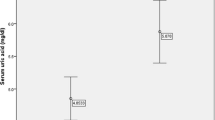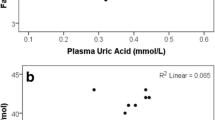Abstract
Background: The relation between serum uric acid (SUA) and metabolic syndrome (MetS) parameters has never been studied in a young Middle-Eastern population. In addition, the relation between SUA and adiponectin was poorly studied. Methods: We looked at the relation between SUA, and both adiponectin and MetS components in 381 randomly selected Lebanese university students (201 males and 180 females). Results: SUA was positively correlated with body mass index (BMI), systolic blood pressure (SBP), diastolic blood pressure (DBP), waist circumference (WC), fasting blood glucose (FPG), triglycerides, total and LDL-cholesterol, and homeostasis model assessment (HOMA) index (p<0.001 for all variables, p<0.01 for FPG) and inversely correlated with HDL-cholesterol and adiponectin (p<0.001 for both variables). In men, SUA was positively correlated with BMI, WC, SBP, DBP, FPG, triglycerides, total and LDL-cholesterol, and HOMA index and inversely correlated with adiponectin (p<0.001 for all variables, p<0.05 for adiponectin); these correlations persisted after BMI adjustment, for WC, FPG, triglycerides, total-cholesterol, LDL-cholesterol, and HOMA index. In women, SUA was positively correlated with total and LDL-cholesterol (p<0.001), independently of BMI. In a multiple regression analysis, SUA was independently associated with WC, triglycerides, total cholesterol, HDL-cholesterol and adiponectin in the overall population while, in men, it was associated with triglycerides, total-cholesterol, and WC. Conclusion: Our results suggest, in young adults, a gender difference in the relation between SUA and both adiponectin and MetS parameters. In addition, we observed in both genders a strong relation of SUA with total cholesterol. Further studies are needed in larger populations in order to elucidate these findings.
Similar content being viewed by others
References
Gagliardi AC, Miname MH, Santos RD. Uric acid: a marker of increased cardiovascular risk. Atherosclerosis 2009, 202: 11–7.
Feig DI, Kang DH, Johnson RJ. Uric acid and cardiovascular risk. N Engl J Med 2008, 359: 1811–21.
Fang J, Alderman MH. Serum uric acid and cardiovascular mortality the NHANES I epidemiologic follow-up study, 1971–1992. National Health and Nutrition Examination Survey. JAMA 2000, 283: 2404–10.
Freedman DS, Williamson DF, Gunter EW, Byers T. Relation of serum uric acid to mortality and ischemic heart disease. The NHANES I Epidemiologic Follow-up Study. Am J Epidemiol 1995, 141: 637–44.
Niskanen LK, Laaksonen DE, Nyyssönen K, et al. Uric acid level as a risk factor for cardiovascular and all-cause mortality in middle-aged men: a prospective cohort study. Arch Intern Med 2004, 164: 1546–51.
Choi HK, Curhan G. Independent impact of gout on mortality and risk for coronary heart disease. Circulation 2007, 116: 894–900.
Johnson RJ, Segal MS, Srinivas T, et al. Essential hypertension, progressive renal disease, and uric acid: a pathogenetic link? J Am Soc Nephrol 2005, 16: 1909–19.
Culleton BF, Larson MG, Kannel WB, Levy D. Serum uric acid and risk for cardiovascular disease and death: The Framingham Heart Study. Ann Intern Med 1999, 131: 7–13.
Wannamethee SG, Shaper AG, Whincup PH. Serum urate and the risk of major coronary heart disease events. Heart 1997, 78: 147–53.
Sui X, Church TS, Meriwether RA, Lobelo F, Blair SN. Uric acid and the development of metabolic syndrome in women and men. Metabolism 2008, 57: 845–52.
Rathmann W, Haastert B, Icks A, Giani G, Roseman JM. Ten-year change in serum uric acid and its relation to changes in other metabolic risk factors in young black and white adults: the CARDIA study. Eur J Epidemiol 2007, 22: 439–45.
Choi HK, Ford ES. Prevalence of the metabolic syndrome in individuals with hyperuricemia. Am J Med 2007, 120: 442–7.
Puig JG, Martínez MA, Mora M, Fraile JM, Montoya F, Torres RJ. Serum urate, metabolic syndrome, and cardiovascular risk factors. A population-based study. Nucleosides Nucleotides Nucleic Acids 2008, 27: 620–3.
Reimann M, Schutte AE, Malan L, Huisman HW, Malan NT. Hyperuricemia is an independent factor for the metabolic syndrome in a sub-Saharan African population: A factor analysis. Atherosclerosis 2008, 197: 638–45.
Lin SD, Tsai DH, Hsu SR. Association between serum uric acid level and components of the metabolic syndrome. J Chin Med Assoc 2006, 69: 512–6.
Kawamoto R, Tomita H, Oka Y, Ohtsuka N. Relationship between serum uric acid concentration, metabolic syndrome and carotid atherosclerosis. Intern Med 2006, 45: 605–14.
Rho YH, Woo JH, Choi SJ, Lee YH, Ji JD, Song GG. Association between serum uric acid and the Adult Treatment Panel II I-defined metabolic syndrome: results from a single hospital database. Metabolism 2008, 57: 71–6.
Ford ES, Li C, Cook S, Choi H K. Serum concentrations of uric acid and the metabolic syndrome among US children and adolescents. Circulation 2007, 115: 2526–32.
Tamba S, Nishizawa H, Funahashi T, et al. Relationship between the serum uric acid level, visceral fat accumulation and serum adiponectin concentration in Japanese men. Intern Med 2008, 47: 1175–80.
Yamamoto Y, Hirose H, Saito I, et al. Correlation of the adipocyte-derived protein adiponectin with insulin resistance index and serum high-density lipoprotein-cholesterol, independent of body mass index, in the Japanese population. Clin Sci (Lond) 2002, 103: 137–42.
Rathmann W, Haastert B, Herder C, et al. Differential association of adiponectin with cardiovascular risk markers in men and women? The KORA survey 2000. Int J Obes 2007, 31: 770–6.
Patel DA, Srinivasan SR, Xu JH, Chen W, Berenson GS. Adiponectin and its correlates of cardiovascular risk in young adults: the Bogalusa Heart Study. Metabolism 2006, 55: 1551–7.
Pittas AG, Joseph NA, Greenberg AS. Adipocytokines and insulin resistance. J Clin Endocrinol Metab 2004, 89: 447–52.
Inadera H. The usefulness of circulating adipokine levels for the assessment of obesity-related health problems. Int J Med Sci 2008, 5: 248–62.
National Cholesterol Education Program (NCEP) Expert Panel on Detection, Evaluation, and Treatment of High Blood Cholesterol in Adults (Adult Treatment Panel III). Third Report of the National Cholesterol Education Program (NCEP) Expert Panel on Detection, Evaluation, and Treatment of High Blood Cholesterol in Adults (Adult Treatment Panel III) final report. Circulation 2002, 106: 3143–421.
Vaccaro O, Masulli M, Cuomo V, et al. Comparative evaluation of simple indices of insulin resistance. Metabolism 2004, 53: 1522–6.
Onat A, Hergenç G, Dursunoglu D, Kùçùkdurmaz Z, Bulur S, Can G. Relatively high levels of serum adiponectin in obese women, a potential indicator of anti-inflammatory dysfunction: relation to sex hormone-binding globulin. Int J Biol Sci 2008, 4: 208–14.
Onat A, Hergenç G, Can G, Kùçùkdurmaz Z. Serum adiponectin confers little protection against diabetes and hypertension in Turkish men. Obesity (Silver Spring) 2009, 17: 564–70.
Lin JD, Chiou WK, Chang HY, Liu FH, Weng HF. Serum uric acid and leptin levels in metabolic syndrome: a quandary over the role of uric acid. Metabolism 2007, 56: 751–6.
Onat A, Uyarel H, Hergenç G, et al. Serum uric acid is a determinant of metabolic syndrome in a population-based study. Am J Hypertens 2006, 19: 1055–62.
Hikita M, Ohno I, Mori Y, Ichida K, Yokose T, Hosoya T. Relationship between hyperuricemia and body fat distribution. Intern Med 2007, 46: 1353–8.
Agamah ES, Srinivasan SR, Webber LS, Berenson GS. Serum uric acid and its relation to cardiovascular disease risk factors in children and young adults from a biracial community: the Bogalusa Heart Study. J Lab Clin Med 1991, 118: 241–9.
Abdullah AR, Hasan HA, Raigangar VL. Analysis of the Relationship of Leptin, High-Sensitivity C-Reactive Protein, Adiponectin, Insulin, and Uric Acid to Metabolic Syndrome in Lean, Overweight, and Obese Young Females. Met Syndr Relat Disord 2008, 7: 17–22.
Tsouli SG, Liberopoulos EN, Mikhailidis DP, Athyros VG, Elisaf MS. Elevated serum uric acid levels in metabolic syndrome: an active component or an innocent bystander? Metabolism 2006, 55: 1293–301.
Cai Z, Xu X, Wu X, Zhou C, Li D. Hyperuricemia and the metabolic syndrome in Hangzhou. Asia Pac J Clin Nutr 2009, 18: 81–7.
Li NF, Wang HM, Yang J, Zhou L, Yao XG, Hong J. Serum uric acid is associated with metabolic risk factors for cardiovascular disease in the Uygur population. Appl Physiol Nutr Metab 2009, 34: 1032–9.
Ka T, Inokuchi T, Tsutsumi Z, Takahashi S, Moriwaki Y, Yamamoto T. Effects of a fenofibrate/losartan combination on the plasma concentration and urinary excretion of purine bases. Int J Clin Pharmacol Ther 2006, 44: 22–6.
Tziomalos K, Kakafika AI, Athyros VG, Karagiannis A, Mikhailidis DP. The role of statins for the primary and secondary prevention of coronary heart disease in women. Curr Pharm Des 2009, 15: 1054–62.
Ebrahimpour P, Fakhrzadeh H, Heshmat R, Bandarian F, Larijani B. Serum uric acid levels and risk of metabolic syndrome in healthy adults. Endocr Pract 2008, 14: 298–304.
Author information
Authors and Affiliations
Corresponding author
Rights and permissions
About this article
Cite this article
Chedid, R., Zoghbi, F., Halaby, G. et al. Serum uric acid in relation with the metabolic syndrome components and adiponectin levels in Lebanese university students. J Endocrinol Invest 34, e153–e157 (2011). https://doi.org/10.3275/7350
Accepted:
Published:
Issue Date:
DOI: https://doi.org/10.3275/7350




